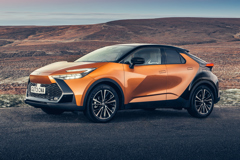Volkswagen T-Roc Review 2025
Volkswagen T-Roc At A Glance
Car manufacturers face a tricky dilemma when it comes to replacing a popular model. If they choose a radical new direction and sales consequently plummet, keyboard warriors are merciless on the social media battlefields, yet if they adhere to the successful formula, motoring writers accuse them of being unadventurous. So, which is it to be for the all-new Volkswagen T-Roc?
Yes, even the most die-hard of VW fans will need to be careful not to crick their necks as they double-take to study the pictures — despite appearances to the contrary, this is a freshly baked model and not a facelift of the previous-generation Volkswagen T-Roc.
That same again styling might appease existing VW T-Roc owners but will it help win Volkswagen new customers against a slew of alternative sportily-shaped SUVs, including the svelte Mazda CX-30, the daring Peugeot 3008 and the even more radical Toyota C-HR among several others?
More important than its evolutionary appearance, VW’s concentrated on improving the new T-Roc in two key areas — self-evidently the original’s styling wasn’t one of them given how many of them can be spotted plying the UK’s roads.
T-Roc Mk2 is longer to the tune of around 12cm, which in turn liberates more interior space, especially for those sat in the back. Volkswagen claims that the latest T-Roc can comfortably accommodate a pair of tall adults behind folk of a similar height sat up front, making it a much more convincing family SUV.
While the interior of the first VW T-Roc looked fine and was generally assembled to a high standard, there was no escaping that its interior material quality lagged behind other similarly priced Volkswagens where squidgy, expensive-feeling plastic mouldings were the norm.
How successful the new T-Roc is at remedying that remains to be seen but if it’s anything like the latest Volkswagen Tiguan — which it certainly appears to be, including adopting its 12.9-inch multimedia touchscreen and separate driver’s display screen. It still has the fiddly touch-sensitive panels beneath for operating the climate control’s temperature settings, but at least they’re permanently on show.
Note also that the upper plane of the dashboard is upholstered in fabric — a growing trend among many car brands. Other changes include interior door release pulls which are pulled up vertically rather than inwards horizontally and as new VW T-Rocs are all automatic, the conventional gear lever on the centre console’s been replaced by one on the right side of the steering column.
Other tech that’s available on the latest T-Roc by dint of using the same fundamental underpinnings as the new Tiguan and the Volkswagen Tayron include Travel Assist that enables automatic lane changes when driving on motorways, with an enhanced, more natural reactions to varying speed limits, as well as Park Assist Pro which allows the car to be manoeuvred in and out of parking spaces using a connected smartphone.
Despite the new T-Roc continuing with its coupe-like tapered roofline, Volkswagen’s eked a further 30 litres of boot space when the rear seats are in position, upping the volume to a very handy 475 litres. No figures have yet been quoted for when they’re folded over, but they do split in a 40/20/40 configuration for added flexibility.
Given the switch to fully-electric drive systems, there’s a significance to the new T-Roc which will seal its place in Volkswagen’s historical annals — it’s to be the final all-new car wearing the VW roundel to be powered by combustion engines. That said, all of them feature differing degrees of hybridisation and none will be diesel-fuelled.
First to arrive are powered by mild hybrid-assisted 1.5-litre eTSI engines in 116PS and 150PS power outputs — at this stage of proceedings no performance or efficiency figures have been published for any of the new T-Rocs.
Those engines will drive the front wheels, while those seeking the additional traction of 4Motion four-wheel drive will have to wait longer as that will be paired with a 2.0-litre eTSI engine with an as-yet undisclosed power output. Arriving even further down the line and topping the range in performance terms using an uprated version of that same engine will be a replacement for the Volkswagen T-Roc R.
Before the 2.0-litre eTSI reaches the market, two different full, self-charging hybrid Volkswagen T-Rocs will go on sale. Details are scant at this juncture but given the expense involved in developing such a system, expect it to quickly become available in other VWs.
On the flip-side, there’s no mention at this stage of VW’s eHybrid plug-in system being available for the new T-Roc but given its commonality with other models that can be ordered in PHEV guise we suspect it’s just a matter of time before it’s confirmed as in the pipeline.
Customer delivers for the new Volkswagen T-Roc aren’t expected to get underway in the UK until early 2026 although order books could open for British buyers before the end of this year’s out. At this stage there’s no official word on pricing although as a steer we would expect an modest elevation from the £29,410 cost of the entry-level version of the outgoing model.
Keep this page bookmarked for further news and our comprehensively detailed full Volkswagen T-Roc review in the coming months.









 Promises to be more spacious and practical than before. Elevated interior quality and tech will be welcome. Full hybrid choice should appease most would-be diesel buyers.
Promises to be more spacious and practical than before. Elevated interior quality and tech will be welcome. Full hybrid choice should appease most would-be diesel buyers.
 Same again styling will please existing owners but will it win new buyers? No official word yet on PHEV models.
Same again styling will please existing owners but will it win new buyers? No official word yet on PHEV models.
.jpg?width=240&height=160&rmode=crop)



